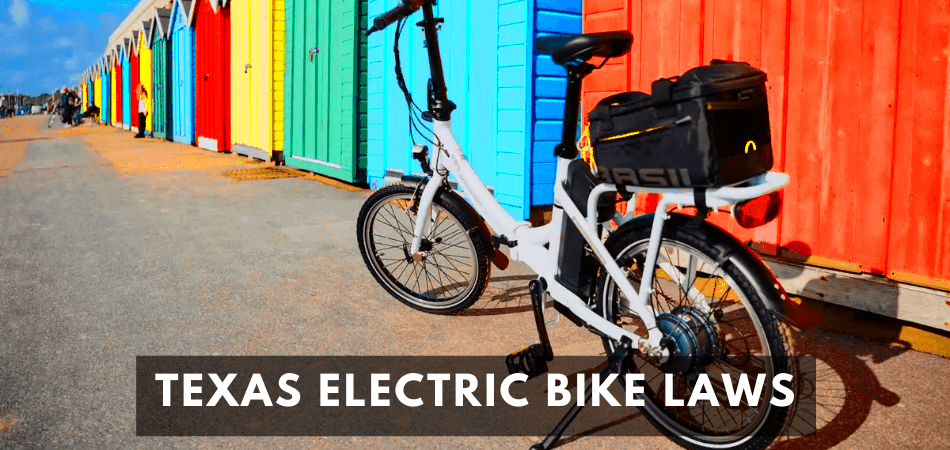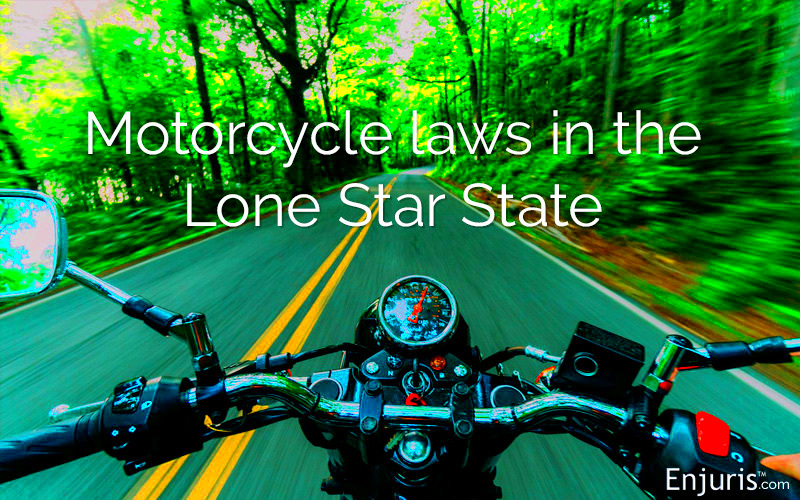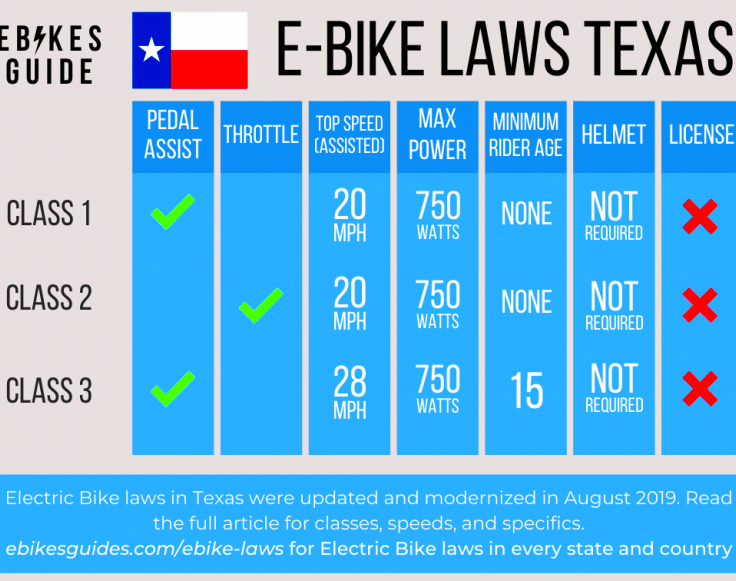Texas E-Bike Laws and What Riders Need to Know
Electric bikes, or e-bikes, are becoming more popular in Texas, offering a convenient and eco-friendly way to get around. However, before you hit the road, it’s important to know the laws that regulate their use. In Texas, e-bikes are treated differently from regular bicycles and motor vehicles. Understanding these laws will ensure a safe and legal riding experience. Whether you’re new to e-bikes or a seasoned rider, having a clear grasp of the rules is essential for avoiding fines and staying safe.
Classification of Electric Bikes in Texas

In Texas, e-bikes are classified into three categories, depending on their speed and motor assistance. These categories help distinguish between different types of e-bikes and ensure that riders use them appropriately.
- Class 1: These e-bikes provide pedal assistance only and stop assisting when the bike reaches 20 mph. Riders must pedal for the motor to engage.
- Class 2: These e-bikes come with a throttle, allowing riders to use the motor without pedaling. The motor also cuts off once the bike reaches 20 mph.
- Class 3: These are pedal-assist bikes, similar to Class 1, but the motor continues assisting until the bike reaches 28 mph. Riders are generally required to wear helmets.
It’s important to know your e-bike’s classification because it can affect where and how you are allowed to ride in Texas.
Where Can You Legally Ride an E-Bike in Texas?

The places where you can legally ride an e-bike vary depending on the type of road or path you are on. Here’s a breakdown:
- Bike Lanes and Shared Paths: Class 1 and 2 e-bikes are typically allowed on bike lanes and shared paths unless local regulations say otherwise. Some restrictions may apply to Class 3 e-bikes.
- Public Roads: E-bikes are allowed on roads with a speed limit of 45 mph or lower. However, riding on highways is not permitted for any e-bike class.
- Off-Road Trails: Many public parks and recreational trails permit e-bikes, but it’s essential to check local rules as some trails restrict motorized bikes.
Staying informed about these regulations will keep you in compliance and ensure your safety and the safety of others.
Speed Limits and Age Restrictions for E-Bike Riders
When it comes to riding e-bikes in Texas, understanding speed limits and age restrictions is crucial. Each class of e-bike has specific guidelines that help keep riders safe and ensure they follow the law.
Speed Limits: Generally, e-bikes have speed limits based on their classification:
- Class 1 and 2: Riders must not exceed 20 mph when using pedal assistance or throttle. This helps prevent accidents, especially in crowded areas.
- Class 3: Riders can go up to 28 mph with pedal assistance. However, many local jurisdictions may impose lower speed limits on specific paths.
Age Restrictions: Texas law also enforces age restrictions for e-bike riders:
- Riders under 14 years old are generally prohibited from using Class 3 e-bikes.
- While there are no specific age limits for Classes 1 and 2, it’s recommended that younger riders be supervised and wear appropriate safety gear.
These rules are designed to keep everyone safe while enjoying the ride, so make sure to follow them!
Helmet and Safety Requirements for E-Bikes
Safety should always be a priority for e-bike riders, and Texas has specific requirements to help ensure you stay protected while on the road. Let’s break it down:
Helmet Requirements: Texas law mandates that:
- Riders under 18 years old must wear a helmet when riding any e-bike.
- While not legally required for adult riders, wearing a helmet is highly recommended to protect against head injuries.
Additional Safety Gear: Besides helmets, consider these safety recommendations:
- Reflective Clothing: Wear bright or reflective clothing to increase visibility, especially during low-light conditions.
- Lights and Bells: Equip your e-bike with front and rear lights, as well as a bell or horn, to alert others to your presence.
Following these safety measures will not only keep you safer but also promote a positive riding culture in Texas.
Texas E-Bike Laws for Different Types of Roads and Trails
Understanding where you can ride your e-bike is essential for compliance and safety. In Texas, different laws apply based on the type of road or trail you are on. Here’s what you need to know:
| Road Type | Allowed E-Bike Classes | Notes |
|---|---|---|
| Bike Lanes | Class 1, Class 2 | Generally permitted unless otherwise stated by local law. |
| Public Roads | All Classes | Speed limit should not exceed 45 mph. |
| Off-Road Trails | Class 1, Class 2 | Check local regulations, as some trails restrict motorized bikes. |
| Sidewalks | Not recommended | Local ordinances may allow, but it’s generally safer to ride on the road. |
Each location may have specific rules, so always look for posted signs and check local laws before riding. Respecting these laws helps everyone enjoy Texas roads and trails safely!
Penalties and Fines for Violating E-Bike Laws
Understanding the penalties and fines associated with violating e-bike laws in Texas is essential for every rider. It helps to keep the riding community safe and ensures compliance with local regulations. Failing to adhere to these laws can lead to consequences that may affect your riding experience.
Common Violations and Their Penalties:
- Riding Without a Helmet: For riders under 18, not wearing a helmet can result in fines ranging from $25 to $200. While adults are not required to wear a helmet, it’s still wise to do so.
- Exceeding Speed Limits: Riding a Class 3 e-bike over the 28 mph limit can lead to fines and potential loss of riding privileges, especially in local areas with stricter regulations.
- Riding in Prohibited Areas: If you ride in areas where e-bikes are not allowed, such as certain off-road trails or highways, you may face fines of $100 or more.
- Improper Use of Equipment: Riding without proper lights, reflectors, or safety features can result in citations that may carry fines.
Remember, the best way to avoid penalties is to familiarize yourself with the local laws and ride responsibly. Awareness not only keeps you safe but also helps maintain a positive image for the e-bike community.
FAQs About Texas E-Bike Laws
Curious about Texas e-bike laws? You’re not alone! Here are some frequently asked questions that can help clarify common concerns among riders:
- Do I need a license to ride an e-bike? No, you do not need a driver’s license to operate an e-bike in Texas, but you must adhere to local regulations.
- Are e-bikes allowed on sidewalks? Generally, it is not recommended to ride e-bikes on sidewalks. Local laws may vary, so always check your area’s rules.
- Can I ride my e-bike on private property? Yes, as long as the property owner permits it. Just be sure to follow any posted guidelines.
- What if my e-bike has a motor over 750 watts? If your e-bike exceeds 750 watts, it may be classified as a motor vehicle, and different laws will apply.
If you have more questions, it’s a good idea to consult local regulations or talk to fellow riders for the latest updates on e-bike laws!
Conclusion and Key Takeaways for E-Bike Riders in Texas
As e-biking continues to grow in popularity across Texas, being informed about the laws and regulations is more important than ever. Here are some key takeaways for every e-bike rider:
- Know Your Class: Understanding the classification of your e-bike will help you navigate local laws more easily.
- Follow Speed Limits: Always adhere to speed limits specific to your e-bike class to avoid penalties and ensure safety.
- Wear Safety Gear: Helmets and reflective clothing can significantly enhance your safety while riding.
- Respect Local Regulations: Always check for local rules regarding where you can ride, especially on trails and sidewalks.
- Stay Informed: E-bike laws may change, so keeping up with local news and regulations can prevent misunderstandings.
By staying informed and riding responsibly, you can enjoy the many benefits of e-biking while ensuring a safe experience for yourself and others on the road. Happy riding!


